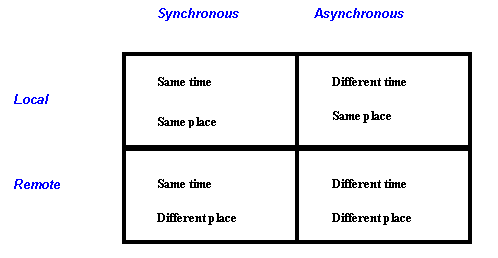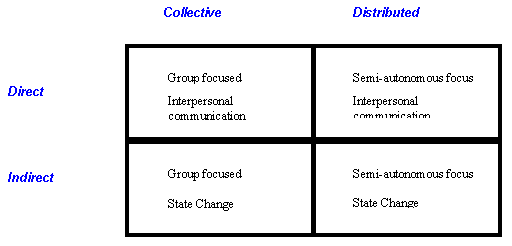
June 2010 Edition
Computer Science Department, University of Cape Town
| MIT Notes Home | Edition Home |
 | MSc-IT Study Material June 2010 Edition Computer Science Department, University of Cape Town | MIT Notes Home | Edition Home | |
When designing computer supported collaborative work systems and applications it is important to understand how they will be used and for what types of tasks. However there has been much controversy over this issue, as conceptualisation of the field should not artificially or inadvertently preclude specific types of cooperative work. Characterising how these systems are used should therefore allow for the rich diversity of forms of cooperative work.
It is important to note that CSCW systems have a varied set of collaborating users that will impact on what systems are required and how the systems are used. Collaborating users may have different:
Goals
Equality of status,
Feelings of comradeship
Organisational alliances
Heuristics and conceptual frameworks
It is important to understand that whilst some groups do have a closed and predetermined character, such as project teams, others are formed and disbanded spontaneously when the need arises. This distinction has been termed the difference between formal and informal groups (Preece, 1995). CSCW systems are increasingly being developed to support informal group collaborations as they are recognised as an important characteristic of the work scenario.
The geographical distribution of group members is an important aspect of group interaction. Cooperative systems are often classified as either local, with group members co-located in the same environment or remote with members at different locations. This divide is concerned as much with the accessibility of users to each other than their physical proximity. Computer support for these interactions has traditionally considered the case of remote asynchronous (at different times) group working. However, more recent research has aimed to support synchronous (at the same time) face-to-face meetings.
The term ‘co-located’ is often referred to instead of ‘local’ to emphasise this logical division. The term local used in this context should not be confusion with the distinction between remote and local communication systems.
The most commonly used classification for the mode of interaction is between asynchronous (occurring at different times) and synchronous (occurring at the same time) working (Preece et al, 1995; Dix, 1998) . These two forms of interaction are important in distinguishing computer support for different tasks. Synchronous cooperation is ideal for creative problem solving, as it often requires immediate input from each group member (i.e. to bounce ideas off of). In contrast, rigid tasks often have a previously formulated strategy whereby group members take on a particular role and work in an asynchronous manner.
Interactions between the form of interaction (synchronous, asynchronous) and the location of the user (local, remote) are often used to define different modes of interaction for CSCW systems. This approach is probably often used because it easily relates to CSCW applications and tools. However as the types of interactions supported by CSCW systems become ever more complex this matrix type approach becomes inadequate.

Group working has been further categorised in a number of different ways. The group work and thus the decision making process can be conducted:
collectively, whereby the group has focused strategies
distributed across the group whereby decisions are made by an ensemble of semi-autonomous workers planning and acting on their own strategies.
Furthermore, cooperative working may be conducted:
indirectly, mediated and guided by the changing state of the process; or directly mediated and guided by direct interpersonal communication.
Interactions between these 4 dimensions can be used to analyse collaborative tasks in more depth. These positions indicate what type of support is required from the technology and potential problems.

How would you define a group that has a scheduled, pre-set agenda?
Answer at the end of the chapter.
Consider the task of ‘writing a co-authored book’ and the task of ‘brain-storming an advertisement campaign’, which task would require synchronous or asynchronous cooperation to be completed most efficiently.
Answer at the end of the chapter.
A group focused collaborative exercise which is guided by changes in the task can be defined as a direct collective collaboration (True / False)
Answer at the end of the chapter.